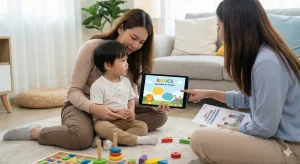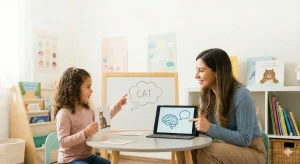Essential Parenting Tips for Effective At-Home Speech Therapy
By Rajini D
Last Updated: July 31, 2024
Discover how these ten essential parenting tips can transform your at-home speech therapy
sessions into a fun, enriching experience. As parents and caregivers, one of the most powerful tools at your disposal is the ability to support your child’s speech development in the comfort of your own home. Whether you’re
new to the concept of home-based speech therapy or looking to enhance your current
practices, the right strategies can make all the difference. This guide will provide you with ten
essential parenting tips to make your at-home speech therapy sessions as effective and
engaging as possible. From setting the right environment to incorporating playful learning,
these tips are designed to help your child thrive in their communication journey.
Essential Parenting Tips for Home Speech Therapy Success
Importance of a Distraction-Free Environment
Creating a distraction-free environment is crucial for effective at-home speech therapy. A focused, clear
setting helps children practice and improve their communication skills without the usual home
distractions. Designating a specific therapy area signals to your child that it’s time to concentrate on their
exercises, making the transition to therapy mode smoother and more consistent.
Tips on Setting Up a Conducive Space at Home
- Choose a Quiet Corner: Select a space in your home that is away from high traffic areas. A quiet
corner in a bedroom, study, or even a section of the living room can work well. - Minimize Clutter: Keep the area tidy and free of non-essential items. Clutter can be visually
distracting and make it difficult for your child to focus on the tasks at hand. - Incorporate Comfort: Ensure the space is comfortable—consider a small table and chairs that
are the right size for your child or a cozy mat for activities that might be done on the floor. - Control Lighting and Sound: Good lighting is essential, especially if your therapy activities
include reading or using visual aids. If possible, control for sound by using soft furnishings like
rugs and curtains that can absorb noise, enhancing the clarity of verbal interactions. - Make it Inviting: Decorate the space with a few favorite but not overly stimulating items, such as
posters of alphabets or characters from favorite books, which can make the area inviting and
personally engaging for your child. - Keep Necessary Tools at Hand: Have all materials needed for therapy sessions easily accessible
in this space. This might include books, flashcards, toys used for therapy, a tablet for digital
exercises, or a whiteboard for drawing and writing. - Flexibility: While it’s important to have a dedicated space, also be flexible about using other
areas of the home occasionally to keep the child engaged and make learning adaptable and fun.
For more tips on creating a conducive environment for therapy, check out our guide on setting up a home therapy space.
2. The Importance of Consistency in Speech Therapy
How Consistency Aids in Speech Development
Consistency is key in many aspects of a child’s learning, particularly in speech development.
Regular practice helps reinforce learning and makes new skills habitual. For children undergoing
speech therapy, a consistent routine offers several benefits:
- Building Language Skills: Regular sessions help reinforce the speech patterns and language skills
the child is learning. This constant practice aids in muscle memory and cognitive recognition,
which are essential for speech and language progress. Over time, children become more
confident and capable in their communication abilities. - Creating Predictability and Comfort: A predictable routine can make children feel more secure
and comfortable. Knowing what to expect can reduce anxiety, which is particularly beneficial for
children who may struggle with speech impediments. - Speeding Progress: Consistent practice can lead to quicker improvements. With regular sessions,
both parents and therapists can promptly identify areas of difficulty and success, adjusting
methods and goals as needed.
For more information on maintaining consistency, visit our article on the importance of regular practice in speech therapy.
3. Planning Effective Speech Therapy Sessions at Home
Creating a successful speech therapy routine at home involves more than just regular practice; it requires thoughtful consideration of the child’s daily activities and individual needs. Here are some tips to help you plan and conduct effective speech therapy sessions at home:
- Set Specific Times: Choose specific times of day for speech therapy activities. These should be
times when your child is typically alert and receptive, such as in the morning after breakfast or a
mid-afternoon session before playtime. - Incorporate Variety: While maintaining a schedule, ensure the activities are varied to keep the
child engaged. Incorporate different types of activities like reading, singing, and interactive play
that naturally encourage speech development. - Be Realistic: Set realistic expectations, and don’t overload your child with long sessions. Short,
frequent sessions are often more effective than longer, sporadic ones, especially for younger
children. - Involve Other Activities: Integrate speech therapy exercises into other daily activities. For
example, during mealtime, focus on naming foods and expressing preferences to make therapy a
natural part of the day. - Stay Flexible: While consistency is important, flexibility is equally crucial. Be prepared to adjust
the schedule based on your child’s mood and responsiveness on any given day. If a planned
session isn’t going well, it’s okay to shorten it or try a different approach. - Consistent Review and Feedback: Regularly review the effectiveness of the schedule with your
child’s speech therapist and make adjustments as necessary. Feedback from a professional can
help tweak the routine for better results.
Also Read: Best Speech Therapy Tips For Parents to Use at Home
4. Use Technology to Your Advantage
Technology is a powerful tool for language learning. Interactive apps, educational games, and online
resources make learning engaging and fun, cater to different learning styles, and provide immediate
feedback. For children, especially those with special needs, integrating technology into speech therapy
can enhance the learning experience and track progress effectively.
Recommended Apps and Tools
One standout tool is the Autism BASICS app, which was honored as the “Best App for Good
2023″ by Google. This app was crafted by a team of dedicated professionals, including
Psychologists, Speech Therapists, Behavioral Therapists, and Occupational Therapists. It’s
designed to engage children with Autism and other special needs positively, providing
structured yet fun activities tailored to their developmental needs.
Features of Autism BASICS:
- Tailored Daily Activities: Parents or therapists can use the app to select and assign
tailored activities with adjustable time settings for daily engagement. These activities,
presented in a playful format, make learning enjoyable and effective. By setting tasks for
the child to watch and learn over a week or more, the child can master each concept at
their own pace and progressively move on to more advanced tasks. Integrating games
and interactive elements keeps children engaged and motivated, making the learning
process both fun and educational. - Activity Library: This resource offers thousands of activities across various categories
critical to the development of children with Autism. From alphabets and spellings to
math and social skills, these activities help enhance behavioral, academic, sensory, and
communication abilities. - Parent Corner: This section provides valuable resources, including videos and content
that empower parents with knowledge about autism, developmental milestones, and
therapeutic approaches. It’s an excellent tool for parents to become more involved and
informed about their child’s progress and needs.
Balancing Screen Time with Interactive Play
While technology like the Autism BASICS app can be a significant asset in home-based speech
therapy, it’s important to balance screen time with interactive play. Integrating technology with
traditional play keeps learning dynamic and helps children apply their digital experiences in
real-world interactions. Tips for this balance include:
- Scheduled Technology Time: Allocate specific periods for app-based learning, ensuring
they complement other play-based learning activities. - Interactive Learning: Choose apps and digital tools that require active participation and
problem-solving, not just passive watching. - Engage Together: Use technology as a tool for joint activities. Engage with your child
using the app, discussing the activities and what they learn, which enhances both their
understanding and your connection with them.
Know more about on How does screen time affect your child’s development?
5. Incorporate Play-Based Learning
Play-based learning integrates educational activities with playful engagement, fostering speech
development and language skills through interactive games. It encourages creativity, social
interaction, and cognitive growth while supporting foundational skills like phonemic awareness,
vocabulary expansion, and storytelling abilities.
Examples of Effective Speech Development Games
- Sound Matching Games: Create cards with pictures that start with different sounds. Ask
your child to match pictures that start with the same sound. This game focuses on
phonemic awareness, which is foundational for speech development. - Blowing Bubbles: Practice making different sounds while blowing bubbles. This activity
helps with breath control, an essential skill for speech production. - Treasure Hunt for Sounds: Organize a treasure hunt where your child finds objects
starting with specific sounds or letters around the house. This encourages active
listening and sound identification, advancing their ability to distinguish sounds. - Simon Says with Mouth Movements: Play “Simon Says” focusing on actions involving
mouth movements, like smiling, frowning, or sticking out the tongue. This game
enhances motor skills needed for clear speech. - Sound Production Practice: Engage in structured exercises where your child practices
producing specific sounds or words they find challenging. Use visual aids and models to
support correct production, reinforcing speech clarity and accuracy.
Language Development Games
- Role Play: Engage in role-playing games where you and your child adopt different
characters. This activity enhances vocabulary by encouraging the use of new words and
phrases in various contexts. It also promotes practicing conversation skills and social
interaction. - Story Cubes: Use story cubes to create random stories together. Roll the dice to get
images and then weave a story using words that start with a particular sound or practice
specific phrases. This game fosters creative thinking, narrative skills, and speech fluency
as children create and articulate stories based on visual prompts. - Puppet Show: Using puppets to act out scenarios or stories encourages children to
engage in imaginative play. This activity not only promotes creativity but also helps in
developing language skills by encouraging storytelling, practicing new vocabulary, and
constructing sentences in a meaningful context. - Rhyming Games: Playing games that involve finding words that rhyme or creating
rhyming pairs enhances phonological awareness. Recognizing and producing rhymes
requires sensitivity to the sounds of language, which is crucial for developing early
literacy skills and improving speech fluency. - Category Sorting Game: Gather objects or pictures and ask your child to sort them into
categories (e.g., animals, colors, shapes). This game promotes language development by
expanding vocabulary and enhancing understanding of word associations and
categorization skills.
How Play Stimulates Language Development:
- Engagement and Motivation: Play keeps children engaged and motivated. They are
more likely to participate in activities that are fun and stimulating, which increases their
exposure to language. - Contextual Learning: Through play, children learn new words and concepts within a
context, making it easier for them to understand and remember what they learn. - Social Interaction: Play often involves other people, whether it’s peers or adults. Social
interactions during play introduce children to turn-taking, understanding instructions,
and using language to express needs and emotions. - Cognitive Development: Play aids cognitive development, which is closely linked to
language skills. As children solve problems, sequence events, and develop narratives in
their play, they simultaneously enhance their language abilities. - Emotional Expression: Play allows children to express their feelings, providing them with
an opportunity to use emotional language and understand the emotional context of
words and sentences.
6. Engage in Daily Conversations
The Role of Everyday Interactions in Speech Therapy
Daily conversations are not just simple exchanges of words; they are crucial building blocks for
language development, especially for children undergoing speech therapy. These interactions
help reinforce the skills being targeted during formal therapy sessions and provide a natural,
stress-free environment where children can practice new sounds, words, and phrases. Engaging
in regular conversations allows children to integrate their speech therapy learnings into real-life
situations, enhancing their confidence and fluency over time.
Tips for Encouraging More Verbal Communication
- Be an Active Listener: Show genuine interest in what your child has to say. Make eye
contact, nod, and respond appropriately to encourage them to continue sharing their
thoughts. - Expand Conversations: When your child says something, expand on it. For instance, if
they say, “dog,” you might reply, “Yes, that’s a big, brown dog. What do you think it’s
doing?” This not only models more complex language structures but also encourages
them to think and express more. - Create Open-Ended Opportunities: Ask questions that require more than yes or no
answers. Questions like “What happened next?” or “Why do you think that?” stimulate
more detailed responses and longer interactions. - Introduce New Vocabulary: During conversations, introduce new words in a natural
context. Help your child understand and use these words, gradually increasing their
vocabulary. - Use Daily Routines as Learning Moments: Incorporate speech practice into everyday
activities. Whether you’re setting the table, shopping, or preparing meals, each moment
is an opportunity to practice and learn new words and concepts. - Encourage Descriptive Speech: When discussing objects or activities, encourage your
child to describe them in detail. This not only improves their descriptive skills but also
helps with their overall communication abilities. - Practice Turn-Taking: Teach your child the art of conversation by practicing turn-taking.
Show them how to listen when someone is speaking and wait for their turn to talk,
which is crucial for social interactions. - Show Patience and Encouragement: Always be patient with your child’s attempts to
communicate. Praise their efforts, no matter how small, to keep them motivated.
7. Read Together Regularly
How Shared Reading Enhances Language Skills
Shared reading, or the act of reading aloud with your child, is a cornerstone of early language
development and speech therapy at home. This practice boosts language skills in several key
ways:
- Vocabulary Expansion: Regularly reading diverse books introduces new words and concepts to
children, helping them build a richer vocabulary. - Listening Skills: Listening to stories helps children develop their auditory processing skills, which
are crucial for understanding spoken language. - Speech Rhythm and Fluency: Children learn about the rhythm and flow of language, including
pauses, intonation, and emphasis, by listening to how words and sentences are read aloud. - Comprehension Skills: Discussing story elements like plot, characters, and setting enhances
understanding and critical thinking skills. - Pronunciation Practice: Hearing words pronounced correctly and consistently helps children
learn how to articulate words properly.
Choosing the Right Books for Speech Development
Selecting appropriate reading material can greatly enhance the effectiveness of shared reading
sessions. Here are some tips for choosing books that support speech development:
- Age-Appropriate Content: Choose books that match your child’s language ability and interests.
For very young children, books with simple sentences and clear, colorful pictures are ideal. - Repetitive and Rhyming Texts: Books that feature repetitive phrases or rhymes encourage
children to remember and speak parts of the text, which aids in learning speech patterns. - Interactive Books: Select books with flaps, textures, or interactive elements that encourage
children to engage more deeply with the content. - Diverse Subjects and Formats: Include a variety of genres and book types, such as storybooks,
factual books, and poetry, to expose your child to different styles of language and content. - Culturally Inclusive Books: Books that reflect diverse cultures and languages can broaden a
child’s understanding and appreciation of the world, fostering more inclusive language skills.
8. Sing Songs and Nursery Rhymes
Benefits of Musical Elements in Speech Therapy
- Enhances Phonemic Awareness: Music and rhythm help children differentiate sounds, a
fundamental skill in speech development. Singing slows down language so children can
better grasp syllable patterns and phonemes. - Improves Memory and Vocabulary: Songs are repetitive and catchy, making them
excellent tools for memory retention. Children learn new words and phrases effortlessly
as they sing along. - Boosts Auditory Processing: Music involves various sounds and patterns. Regular
exposure to songs helps children enhance their ability to process and interpret auditory
information. - Encourages Expressive Language: Singing involves expression both through lyrics and
emotions. This encourages children to express themselves more freely in their speech. - Strengthens Listening Skills: Learning songs requires listening closely to words and
melodies, thereby sharpening listening skills that are crucial for speech development.
Easy and Fun Songs to Incorporate into Daily Routines
- “The Wheels on the Bus”: This song offers a great mix of repetitive phrases and simple
rhythms, making it easy for children to memorize and sing along. It also introduces a
variety of sounds and words related to everyday objects and actions. - “Old MacDonald Had a Farm”: This classic tune is perfect for teaching animal sounds
and names, practicing the formation of different sounds in a fun context. - “Twinkle, Twinkle, Little Star”: A gentle melody that is easy to learn. It helps in teaching
pitch variation and rhythm, which are essential components of speech. - “Head, Shoulders, Knees, and Toes”: This song not only teaches body parts but also
involves physical movement which can help in motor skill development alongside
speech. - “If You’re Happy and You Know It”: This song can be adapted with different actions and
expressions, making it a versatile tool for teaching verbs and emotional expressions.
9. Use Visual Aids and Gestures
How Visuals and Hand Gestures Aid in Communication
Visual aids and hand gestures play a significant role in enhancing communication, especially in
the context of speech therapy. For children, especially those who are visual learners or may
have speech and language delays, these tools can be incredibly effective. Here’s how they help:
- Reinforcement of Learning: Visuals can reinforce what is being spoken, helping to solidify
understanding and retention of words and concepts. - Non-Verbal Cues: Gestures can provide context clues that assist in the comprehension of
speech, which is particularly helpful for children struggling with auditory processing. - Engagement and Attention: Colorful and engaging visuals can capture and maintain a child’s
interest during therapy sessions, making learning more enjoyable. - Memory Aids: Using consistent gestures for certain actions or objects can help children
remember new words and their meanings. - Clarification of Abstract Concepts: Visuals can help explain abstract concepts by giving them a
tangible form, which simplifies the learning process.
DIY Visual Aids for Home Use
Creating effective visual aids doesn’t have to be costly or time-consuming. Here are some DIY
ideas that parents can easily implement at home:
- Picture Cards: Use magazines, old books, or print images from the internet to make picture cards
of common items, actions, or emotions. Laminate them for durability and use them to build
vocabulary or create storytelling sequences. - Handmade Flashcards: Draw or paint images on cardstock or use stickers. These can be used for
matching games, memory games, or as prompts during reading and conversation activities. - Gesture Chart: Create a chart with photographs or drawings of common gestures (like waving for
‘hello’ or goodbye,’ nodding for ‘yes,’ and shaking the head for ‘no’). Refer to the chart during
daily activities to reinforce these non-verbal cues. - Storyboards: Illustrate simple stories or daily routines on poster boards. This helps children
anticipate what comes next and supports their ability to narrate sequences and events. - Visual Schedules: Help your child understand and manage their daily routines by creating a
visual schedule. Use pictures to represent different parts of the day, such as mealtime, playtime,
and therapy sessions. This aids in establishing routines and making transitions smoother.
10. Using Recordings for Feedback to Improve Speech Clarity
Using recordings can provide valuable insights into how a child is pronouncing and articulating words.
Listening to themselves can help children understand how they are producing words, revealing issues
that aren’t always apparent in real time.
Devices for Recording
Various devices can be used for recording, such as smartphones, tablets, or digital recorders. These tools are readily available and easy to use, making it convenient to capture and review speech sessions.
Benefits of Listening to Recordings
Children can listen to their recordings to identify specific areas needing improvement, such as the
pronunciation of certain sounds or the pace of their speech. This self-awareness can be crucial for
making progress in speech clarity.
Involving Speech Therapists
Share these recordings with professional speech therapists to get additional feedback. This collaboration
can help refine the therapy process, providing targeted advice and strategies to further improve the
child’s speech development.
11. Stay Informed and Consult Professionals
Importance of Continuous Learning for Parents
- Stay Updated: Keeping up with the latest developments in speech therapy can significantly
enhance the effectiveness of your home sessions. Regularly reading reliable sources like speech
therapy blogs, especially those created by experts at Wellness Hub, can provide you with
innovative ideas and the latest best practices. - Learning Resources: Utilize educational materials such as books, online courses, and webinars
dedicated to speech therapy techniques. These resources are not only designed to educate but
also to empower parents with skills and knowledge to better support their child’s speech
development.
When to Seek Additional Professional Help
- Monitoring Progress: Understand the milestones in speech development and observe if your
child’s progress aligns with these benchmarks. Regular assessments can help determine the
effectiveness of your at-home therapy. - Professional Guidance Needed: If you notice your child is consistently struggling or if there is a
plateau in progress, it may be time to consult a speech-language pathologist. These professionals
can offer specialized interventions and guide how to integrate their recommendations into your
home practice. - Accessing Additional Resources: Sometimes, children may require more intensive therapy or
specific interventions that only certified professionals can provide. Engaging with a professional
can also provide access to specialized tools and techniques that can significantly benefit your
child’s speech therapy journey.
Conclusion:
Empowering your child’s communication journey begins with the steps you take at home. By
implementing these essential parenting tips for at-home speech therapy, you’re enhancing your
child’s ability to communicate and strengthen your bond through interactive and supportive
practices. Remember, the path to improved speech and language skills is a journey that requires
patience, persistence, and positivity. Your active involvement is crucial to your child’s progress,
and every small success is a step towards greater confidence and capabilities. So, embrace these
moments, celebrate the milestones, no matter how small, and continue to be the guiding force
in your child’s developmental journey. Together, you can achieve remarkable improvements and
make lasting impacts on their communication skills.
For more detailed information and resources, visit Wellness Hub.
About the Author:
Rajini Darugupally
M.Sc., Speech-Language Pathologist (9+ years of experience)
Rajini is a passionate and dedicated Speech-Language Pathologist with over 9+ years of experience, specializing in both developmental speech and language disorders in children and rehabilitation in adults. Driven by a desire to empower each individual to find their voice, Rajini brings a wealth of experience and a warm, genuine approach to therapy. Currently, at Wellness Hub, she thrives in a team environment that values innovation, compassion, and achieving results for their clients.
Book your Free Consultation Today
Parent/Caregiver Info:
Client’s Details:
* Error Message









